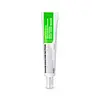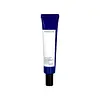What's inside
What's inside
 Key Ingredients
Key Ingredients

 Benefits
Benefits

 Concerns
Concerns

 Ingredients Side-by-side
Ingredients Side-by-side

Centella Asiatica Extract
CleansingWater
Skin ConditioningHydrogenated Poly(C6-14 Olefin)
EmollientGlycerin
HumectantCetyl Ethylhexanoate
EmollientCaprylic/Capric Triglyceride
MaskingCetyl Alcohol
Emollient1,2-Hexanediol
Skin ConditioningButylene Glycol
HumectantDipropylene Glycol
HumectantMethyl Trimethicone
Skin ConditioningPentaerythrityl Tetraisostearate
EmollientDipentaerythrityl Hexa C5-9 Acid Esters
Skin ConditioningPotassium Cetyl Phosphate
EmulsifyingSodium Hyaluronate
HumectantButyrospermum Parkii Butter
Skin ConditioningPanthenol
Skin ConditioningPalmitoyl Dipeptide-10
Skin ConditioningPalmitoyl Tripeptide-1
Skin ConditioningPalmitoyl Tetrapeptide-7
Skin ConditioningPalmitoyl Hexapeptide-12
Skin ConditioningPolyglyceryl-2 Stearate
EmulsifyingAsiaticoside
AntioxidantAsiatic Acid
Skin ConditioningMadecassic Acid
Skin ConditioningStearic Acid
CleansingGlyceryl Stearate
EmollientStearyl Alcohol
EmollientMacadamia Ternifolia Seed Oil
EmollientLimnanthes Alba Seed Oil
Skin ConditioningArgania Spinosa Kernel Oil
EmollientCaprylyl Glycol
EmollientCetearyl Olivate
Sorbitan Olivate
EmulsifyingCamellia Sinensis Extract
AntioxidantPancratium Maritimum Extract
BleachingAcetyl Glucosamine
Skin ConditioningCeramide NP
Skin ConditioningAcrylates/C10-30 Alkyl Acrylate Crosspolymer
Emulsion StabilisingAdenosine
Skin ConditioningTromethamine
BufferingCarbomer
Emulsion StabilisingDisodium EDTA
Lavandula Angustifolia Oil
MaskingCitrus Aurantium Bergamia Fruit Oil
MaskingCentella Asiatica Extract, Water, Hydrogenated Poly(C6-14 Olefin), Glycerin, Cetyl Ethylhexanoate, Caprylic/Capric Triglyceride, Cetyl Alcohol, 1,2-Hexanediol, Butylene Glycol, Dipropylene Glycol, Methyl Trimethicone, Pentaerythrityl Tetraisostearate, Dipentaerythrityl Hexa C5-9 Acid Esters, Potassium Cetyl Phosphate, Sodium Hyaluronate, Butyrospermum Parkii Butter, Panthenol, Palmitoyl Dipeptide-10, Palmitoyl Tripeptide-1, Palmitoyl Tetrapeptide-7, Palmitoyl Hexapeptide-12, Polyglyceryl-2 Stearate, Asiaticoside, Asiatic Acid, Madecassic Acid, Stearic Acid, Glyceryl Stearate, Stearyl Alcohol, Macadamia Ternifolia Seed Oil, Limnanthes Alba Seed Oil, Argania Spinosa Kernel Oil, Caprylyl Glycol, Cetearyl Olivate, Sorbitan Olivate, Camellia Sinensis Extract, Pancratium Maritimum Extract, Acetyl Glucosamine, Ceramide NP, Acrylates/C10-30 Alkyl Acrylate Crosspolymer, Adenosine, Tromethamine, Carbomer, Disodium EDTA, Lavandula Angustifolia Oil, Citrus Aurantium Bergamia Fruit Oil
Water
Skin ConditioningGlycerin
HumectantDipropylene Glycol
HumectantTriethylhexanoin
MaskingBis-Diglyceryl Polyacyladipate-2
EmollientCetearyl Alcohol
EmollientPolyglyceryl-3 Distearate
EmulsifyingButyrospermum Parkii Butter
Skin ConditioningNiacinamide
SmoothingCyclopentasiloxane
EmollientMethylpropanediol
SolventGlyceryl Stearate
EmollientGlyceryl Caprylate
EmollientCarbomer
Emulsion StabilisingSorbitan Sesquioleate
EmulsifyingGlyceryl Stearate Citrate
EmollientSodium Methyl Stearoyl Taurate
CleansingPotassium Hydroxide
BufferingCaprylic/Capric Triglyceride
MaskingCetyl Ethylhexanoate
EmollientEthylhexyl Palmitate
EmollientAdenosine
Skin ConditioningEthylhexylglycerin
Skin ConditioningTocopheryl Acetate
AntioxidantDisodium EDTA
Hydrogenated Lecithin
EmulsifyingPanax Ginseng Root Extract
EmollientCamellia Sinensis Leaf Extract
AntimicrobialTremella Fuciformis Extract
HumectantButylene Glycol
HumectantMacadamia Ternifolia Seed Oil
EmollientPentylene Glycol
Skin ConditioningHydroxyacetophenone
AntioxidantCaprylyl Glycol
Emollient1,2-Hexanediol
Skin ConditioningCholesterol
EmollientBrassica Campestris Sterols
EmollientPhytosteryl/Behenyl/Octyldodecyl Lauroyl Glutamate
Skin ConditioningPolyglyceryl-10 Oleate
Skin ConditioningPotassium Cetyl Phosphate
EmulsifyingCeramide NP
Skin ConditioningAstragalus Membranaceus Root Extract
EmollientCeramide Ns
Skin ConditioningCeramide EOP
Skin ConditioningWater, Glycerin, Dipropylene Glycol, Triethylhexanoin, Bis-Diglyceryl Polyacyladipate-2, Cetearyl Alcohol, Polyglyceryl-3 Distearate, Butyrospermum Parkii Butter, Niacinamide, Cyclopentasiloxane, Methylpropanediol, Glyceryl Stearate, Glyceryl Caprylate, Carbomer, Sorbitan Sesquioleate, Glyceryl Stearate Citrate, Sodium Methyl Stearoyl Taurate, Potassium Hydroxide, Caprylic/Capric Triglyceride, Cetyl Ethylhexanoate, Ethylhexyl Palmitate, Adenosine, Ethylhexylglycerin, Tocopheryl Acetate, Disodium EDTA, Hydrogenated Lecithin, Panax Ginseng Root Extract, Camellia Sinensis Leaf Extract, Tremella Fuciformis Extract, Butylene Glycol, Macadamia Ternifolia Seed Oil, Pentylene Glycol, Hydroxyacetophenone, Caprylyl Glycol, 1,2-Hexanediol, Cholesterol, Brassica Campestris Sterols, Phytosteryl/Behenyl/Octyldodecyl Lauroyl Glutamate, Polyglyceryl-10 Oleate, Potassium Cetyl Phosphate, Ceramide NP, Astragalus Membranaceus Root Extract, Ceramide Ns, Ceramide EOP
 Reviews
Reviews

Ingredients Explained
These ingredients are found in both products.
Ingredients higher up in an ingredient list are typically present in a larger amount.
1,2-Hexanediol is a synthetic liquid and another multi-functional powerhouse.
It is a:
- Humectant, drawing moisture into the skin
- Emollient, helping to soften skin
- Solvent, dispersing and stabilizing formulas
- Preservative booster, enhancing the antimicrobial activity of other preservatives
Adenosine is in every living organism. It is one of four components in nucleic acids that helps store our DNA.
Adenosine has many benefits when used. These benefits include hydrating the skin, smoothing skin, and reducing wrinkles. Once applied, adenosine increases collagen production. It also helps with improving firmness and tissue repair.
Studies have found adenosine may also help with wound healing.
In skincare products, Adenosine is usually derived from yeast.
Learn more about AdenosineButylene Glycol (or BG) is used within cosmetic products for a few different reasons:
Overall, Butylene Glycol is a safe and well-rounded ingredient that works well with other ingredients.
Though this ingredient works well with most skin types, some people with sensitive skin may experience a reaction such as allergic rashes, closed comedones, or itchiness.
Learn more about Butylene GlycolThis ingredient is also known as shea butter. It is an effective skin hydrator and emollient.
Emollients help soothe and soften your skin. It does this by creating a protective film on your skin. This barrier helps trap moisture and keeps your skin hydrated. Emollients may be effective at treating dry or itchy skin.
Shea butter is rich in antioxidants. Antioxidants help fight free-radicals, or molecules that may harm the body. It is also full of fatty acids including stearic acid and linoleic acid. These acids help replenish the skin and keep skin moisturized.
While Shea Butter has an SPF rating of about 3-4, it is not a sunscreen replacement.
Shea butter may not be fungal acne safe. We recommend speaking with a professional if you have any concerns.
Learn more about Butyrospermum Parkii ButterThis ingredient is an emollient, solvent, and texture enhancer. It is considered a skin-softener by helping the skin prevent moisture loss.
It helps thicken a product's formula and makes it easier to spread by dissolving clumping compounds.
Caprylic Triglyceride is made by combining glycerin with coconut oil, forming a clear liquid.
While there is an assumption Caprylic Triglyceride can clog pores due to it being derived from coconut oil, there is no research supporting this.
Learn more about Caprylic/Capric TriglycerideCaprylyl Glycol is a humectant and emollient, meaning it attracts and preserves moisture.
It is a common ingredient in many products, especially those designed to hydrate skin. The primary benefits are retaining moisture, skin softening, and promoting a healthy skin barrier.
Though Caprylyl Glycol is an alcohol derived from fatty acids, it is not the kind that can dry out skin.
This ingredient is also used as a preservative to extend the life of products. It has slight antimicrobial properties.
Learn more about Caprylyl GlycolCarbomer is a polymer of acrylic acid. Its main role is to create a gel consistency.
A high amount of carbomer can cause pilling or balling up of products. Don't worry, most products contain 1% or less of carbomer.
Ceramide NP is a type of ceramide and formally known as ceramide 3.
Ceramides are intercellular lipids naturally found in our skin that bonds dead skin cells together to create a barrier. They are known for their ability to hold water and thus are a great ingredient for dry skin.
Ceramides are an important building block for our skin barrier. A stronger barrier helps the skin look more firm and hydrated. By bolstering the skin ceramides act as a barrier against irritating ingredients. This can help with inflammation as well.
If you would like to eat ceramides, sweet potatoes contain a small amount.
Read more about other common types of ceramides here:
Ceramide AP
Ceramide EOP
Cetyl Ethylhexanoate is an emollient ester. It comes from cetearyl alcohol and 2-ethylhexanoic acid.
Cetyl Ethylhexanoate is an emollient that adds a velvety feel to skin without being greasy or oily. Emollients help trap moisture into your skin, keeping your skin soft and hydrated.
Dipropylene Glycol is a synthetically created humectant, stabilizer, and solvent.
This ingredient helps:
Dipropylene glycol is technically an alcohol, but it belongs to the glycol family (often considered part of the ‘good’ alcohols). This means it is hydrating and gentle on skin unlike drying solvent alcohols like denatured alcohol.
As a masking agent, Dipropylene Glycol can be used to cover the smell of other ingredients. However, it does not have a scent.
Studies show Dipropylene Glycol is considered safe to use in skincare.
Learn more about Dipropylene GlycolDisodium EDTA plays a role in making products more stable by aiding other preservatives.
It is a chelating agent, meaning it neutralizes metal ions that may be found in a product.
Disodium EDTA is a salt of edetic acid and is found to be safe in cosmetic ingredients.
Learn more about Disodium EDTAGlycerin is already naturally found in your skin. It helps moisturize and protect your skin.
A study from 2016 found glycerin to be more effective as a humectant than AHAs and hyaluronic acid.
As a humectant, it helps the skin stay hydrated by pulling moisture to your skin. The low molecular weight of glycerin allows it to pull moisture into the deeper layers of your skin.
Hydrated skin improves your skin barrier; Your skin barrier helps protect against irritants and bacteria.
Glycerin has also been found to have antimicrobial and antiviral properties. Due to these properties, glycerin is often used in wound and burn treatments.
In cosmetics, glycerin is usually derived from plants such as soybean or palm. However, it can also be sourced from animals, such as tallow or animal fat.
This ingredient is organic, colorless, odorless, and non-toxic.
Glycerin is the name for this ingredient in American English. British English uses Glycerol/Glycerine.
Learn more about GlycerinGlyceryl Stearate is a mix of glycerin and stearic acid.
It is used to stabilize the mixing of water and oil ingredients. By preventing these ingredients from separating, it can help elongate shelf life. It can also help thicken the product's texture.
As an emollient, it helps soften skin and supports barrier-replenishing ingredients.
In cosmetics, Glyceryl Stearate is often made from vegetable oils or synthetically produced.
This ingredient may not be fungal-acne safe
Fun fact: The human body also creates Glyceryl Stearate naturally.
Learn more about Glyceryl StearateMacadamia Ternifolia Seed Oil is the fixed oil obtained from Macadamia nut.
Macadamia seed oil is rich in fatty acids, including oleic acid (45-75%), palmitoleic acid (7-33%), and palmitic acid (6-12%). They also contain various B vitamins, iron, and magnesium.
Palmitoleic acid has been shown to help soothe inflammation and promote wound healing. It is also naturally found in the fat of our skin.
Macadamia seed oil may not be malassezia folliculitis, or fungal-acne, safe.
Learn more about Macadamia Ternifolia Seed OilPotassium Cetyl Phosphate is the potassium salt of a mixture. This mixture consists of the esters from phosphoricacid and cetyl alcohol.
Potassium Cetyl Phosphate is an emulsifier and cleansing agent. Emulsifiers help stabilize a product. It does this by preventing certain ingredients from separating.
As a cleansing agent, Potassium Cetyl Phosphate helps gather oils, dirts, and pollutants from your skin. This makes it easier to rinse them away with water.
Learn more about Potassium Cetyl PhosphateWater. It's the most common cosmetic ingredient of all. You'll usually see it at the top of ingredient lists, meaning that it makes up the largest part of the product.
So why is it so popular? Water most often acts as a solvent - this means that it helps dissolve other ingredients into the formulation.
You'll also recognize water as that liquid we all need to stay alive. If you see this, drink a glass of water. Stay hydrated!
Learn more about Water